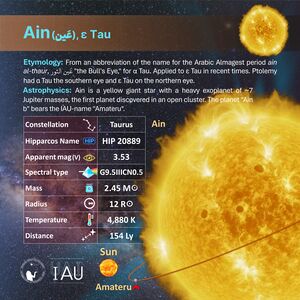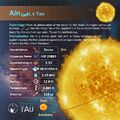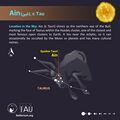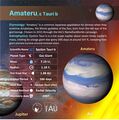Ain: Difference between revisions
IanRidpath (talk | contribs) No edit summary |
No edit summary |
||
| Line 1: | Line 1: | ||
[[File:Ain profileCard SadeghFaghanpour-IAU-WGSN.jpg|thumb|Ain - profile card (CC BY Sadegh Faghanpour for IAU-WGSN).]] |
|||
Ain is a modern star name adopted by the International Astronomical Union in the IAU-Catalog of Star Names (IAU-CSN). Its origin is Arabic. It is the name of HIP 20889 (ε Tau, HR 1409) in constellation Tau. |
Ain is a modern star name adopted by the International Astronomical Union in the IAU-Catalog of Star Names (IAU-CSN). Its origin is Arabic. It is the name of HIP 20889 (ε Tau, HR 1409) in constellation Tau. |
||
==Etymology and History== |
==Etymology and History== |
||
Kunitzsch and Smart (2006) think, the name is an abbreviation of the scholarly Arabic in mediaeval times, name ''ain al-thaur'', "the Bull's Eye", for α Tau which was applied to ε Tau in recent times. However, Ptolemy had α Tau the southern eye, and ε Tau on the northern eye. |
|||
=== Ptolemy's Almagest (~135 CE) === |
|||
{| class="wikitable" |
|||
!id |
|||
!Greek |
|||
(Heiberg 1898) |
|||
!English |
|||
(Toomer 1984) |
|||
!ident. |
|||
|- |
|||
! |
|||
!Ταύρου ἀστερισμός |
|||
!Constellation of [[Taurus]] |
|||
! |
|||
|- |
|||
| |
|||
| |
|||
| |
|||
| |
|||
|- |
|||
|14 |
|||
|ὁ λαμπρὸς τῶν Ῥάδων ἐπὶ τοῦ νοτίου ὀφθαλμοῦ ὑπόκιρρος |
|||
|The stars in the face, called 'the Hyades': the bright star ofthe Hyades, the reddishone on the southern eye |
|||
|α Tau |
|||
|- |
|||
|15 |
|||
|ὁ λοιπὸς καὶ ἐπὶ τοῦ βορεύου ὀφθαλμοῦ |
|||
|The stars in the face, called 'the Hyades': the remaining one, on the nordlern eye |
|||
|ε Tau |
|||
|} |
|||
==== Arabic translation ==== |
|||
{| class="wikitable" |
|||
|14 |
|||
|... |
|||
|النجوم في الوجه، تسمى ”الهياديس“: النجم الساطع من الهياديس، النجم المحمر في العين الجنوبية |
|||
| |
|||
|α Tau |
|||
|- |
|||
|15 |
|||
|... |
|||
|النجوم في الوجه، تسمى ”الهياديس“: النجمة المتبقية، على العين الشمالية |
|||
| |
|||
|ε Tau |
|||
|} |
|||
The fact of [[Taurus]], the Bull, consists of two eyes, nostrils and other stars in the Hyadres star cluster. So, the name "Eye" can be a direct translation from Ancient Greek to Arabic. |
|||
==Mythology== |
==Mythology== |
||
==IAU Working Group on Star Names== |
==IAU Working Group on Star Names== |
||
The name was adopted by the IAU WGSN on 2015/12/15. |
The name was adopted by the IAU WGSN on 2015/12/15. The star is a yellow giant with a confirmed exoplanet which was named simultaneously with the star (Amateru). <gallery> |
||
File:Ain profileCard SadeghFaghanpour-IAU-WGSN.jpg|Ain - profile card (CC BY Sadegh Faghanpour for IAU-WGSN). |
|||
File:Ain stickfigure SadeghFaghanpour-IAU-WGSN.jpg|Ain - stickfigure (CC BY Sadegh Faghanpour for IAU-WGSN). |
|||
File:Amateru profileCard SadeghFaghanpour-IAU-WGSN.jpg|Ain's planet Amateru - profile card (CC BY Sadegh Faghanpour for IAU-WGSN). |
|||
</gallery> |
|||
==Weblinks== |
==Weblinks== |
||
Revision as of 19:42, 5 November 2025
Ain is a modern star name adopted by the International Astronomical Union in the IAU-Catalog of Star Names (IAU-CSN). Its origin is Arabic. It is the name of HIP 20889 (ε Tau, HR 1409) in constellation Tau.
Etymology and History
Kunitzsch and Smart (2006) think, the name is an abbreviation of the scholarly Arabic in mediaeval times, name ain al-thaur, "the Bull's Eye", for α Tau which was applied to ε Tau in recent times. However, Ptolemy had α Tau the southern eye, and ε Tau on the northern eye.
Ptolemy's Almagest (~135 CE)
| id | Greek
(Heiberg 1898) |
English
(Toomer 1984) |
ident. |
|---|---|---|---|
| Ταύρου ἀστερισμός | Constellation of Taurus | ||
| 14 | ὁ λαμπρὸς τῶν Ῥάδων ἐπὶ τοῦ νοτίου ὀφθαλμοῦ ὑπόκιρρος | The stars in the face, called 'the Hyades': the bright star ofthe Hyades, the reddishone on the southern eye | α Tau |
| 15 | ὁ λοιπὸς καὶ ἐπὶ τοῦ βορεύου ὀφθαλμοῦ | The stars in the face, called 'the Hyades': the remaining one, on the nordlern eye | ε Tau |
Arabic translation
| 14 | ... | النجوم في الوجه، تسمى ”الهياديس“: النجم الساطع من الهياديس، النجم المحمر في العين الجنوبية | α Tau | |
| 15 | ... | النجوم في الوجه، تسمى ”الهياديس“: النجمة المتبقية، على العين الشمالية | ε Tau |
The fact of Taurus, the Bull, consists of two eyes, nostrils and other stars in the Hyadres star cluster. So, the name "Eye" can be a direct translation from Ancient Greek to Arabic.
Mythology
IAU Working Group on Star Names
The name was adopted by the IAU WGSN on 2015/12/15. The star is a yellow giant with a confirmed exoplanet which was named simultaneously with the star (Amateru).
Weblinks
- Website of the IAU WGSN: https://exopla.net/
Reference
- References (general)
- Kunitzsch, Paul; Smart, Tim (2006). A Dictionary of Modern star Names: A Short Guide to 254 Star Names and Their Derivations (2nd rev. ed.). Cambridge, Massachusetts: Sky Pub.








